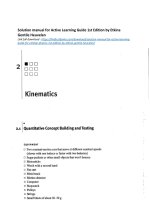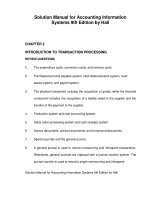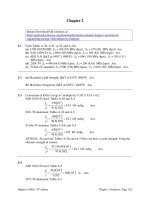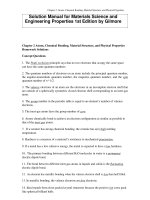Download PDF solution manual for microelectronic circuit design 5th edition by jaege
Bạn đang xem bản rút gọn của tài liệu. Xem và tải ngay bản đầy đủ của tài liệu tại đây (1.66 MB, 17 trang )
CHAPTER 2
Solution Manual for Microelectronic Circuit
Design 5th Edition by Jaege
2.1
Based upon Table 2.1, a resistivity of 2.82 -cm < 1 m-cm, and aluminum is a conductor.
2.2
Based upon Table 2.1, a resistivity of 10
15
5
-cm > 10 -cm, and silicon dioxide is an insulator.
2.3
2.4
1.8 2 cm
2.82 x10 6 cm
144
4
4
A
5x10 cm 1x10 cm
L
a R
L
b R
2.82x10 cm
6
A
1.8 2 cm
5x10
4
287
4
cm0.5x10 cm
2.5
a R L 1.66x106 cm
1.8 2 cm
A
b R L 1.66 x106 cm
5x10
5x10
A
4
4
94.5
cm1x10 4 cm
1.8 2 cm
169
cm0.5x10 4 cm
2.6
2-1
©R. C. Jaeger & T. N. Blalock 3/23/15
2
= BT 3
ni
1010
æ -E ö
÷
è kT ø
expç
31
B=1.08x10
G
1.12 ö÷
è 8.62x10 T ø
Using a spreadsheet, solver, or MATLAB yields T=305.23K
2
31
3
æ
=1.08x10 T expç-
5
Define an M-File:
function f=temp(T)
f=1e20-1.08e31*T^3*exp(-1.12/(8.62e-5*T));
Then: fzero('temp',300) | ans = 305.226 K
2.7
For silicon, B = 1.08 x 1031 and EG = 1.12 eV:
ni = 5.07 x10-19/cm3
1.69 x 1013/cm3.
6.73 x109/cm3
For germanium, B = 2.31 x 1030 and EG = 0.66 eV:
ni = 2.63 x10-4/cm3
2.93 x 1015/cm3.
2.27 x1013/cm3
2.8
(a) Define an M-File:
function f=temp(T)
ni=1E15;
f=ni^2-1.08e31*T^3*exp(-1.12/(8.62e-5*T));
15
3
ni = 10 /cm for T = 602 K
15
b N
15
=10
3
cm
, n =10
D
p=
n
n
15
cm
3
10
15 2
+
:n =
10
i
10
2
i
2
30
=
15
=6.18x10
15
+ 4 10
2
15
=1.62 x10
/ cm 3
2
14
/ cm
3
1.62 x10
c At room temperature, ND >> ni2.
\n = ND =1015 electrons / cm3 and p = ni2 = 1020 =105 holes / cm3
n 1015
2.9
6
3
T = 300 K and EG = 1.42 eV: ni = 2.21 x10 /cm
2-2
©R. C. Jaeger & T. N. Blalock 3/23/15
T = 100 K: ni = 6.03 x 10
-19
3
/cm
10
3
10
3
T = 450 K: ni = 3.82 x10 /cm
6
3
T = 300 K and EG = 1.42 eV: ni = 2.21 x10 /cm
T = 100 K: ni = 6.03 x 10
-19
3
/cm
T = 450 K: ni = 3.82 x10 /cm
2-3
©R. C. Jaeger & T. N. Blalock 3/23/15
2.10
cm 2 öæ
Vö
æ
÷ç-2000 ÷ = +1.40x10
v = - E = ç-700 V
n
è
n
- s øè
v = + E = ç+250 V
è
p
Vö
cm
÷ = -5.00 x10 5 s
öæ
֍-2000
- s øè
cm ø
p
n
j
s
cm ø
cm 2
æ
cm
6
n
=
= -qnv
æ
19
-1.60 x10
1
17
ç
C
3 öæ
֍
10
6
cm ö
A2
4
÷
= 2.24x10
1.40 x10
ø
cm è
è
s ø
cm
1 öæ
cm ö
A
j p = qnv p = 1.60 x1019 C æ10 3 3 ÷ç -5.00 x105
÷ = -8.00 x1011
è cm øè
s ø
cm
2.11
j
n
n
= qnv
=
2
ç
æ
19
ç
C
1.60x10
è
j p = qnv p = 1.60x1019 C
n
6
I = j · Area =1.60x10
æ
ç
è
A
cm
1 öæ
cm ö =1.60x10
A 2 =1.60 MA
cm øè
s ø
cm
cm
1 öæ cm ö
A
pA
= 160
102
107
÷ =1.60x1010
2
2
cm øè
s ø
cm
cm
2
4
4
10 cm 25x10 cm = 400 mA
18
3
7
֍
6
÷
10
10
2
3 ֍
2.12
2.13
2
v = j = 2500A / cm = 2.5x10 5 cm
2
Q 0.01C / cm
s
2.14
æ
vn = - E = - 1000
cm 2 öæ
ç
è
n
æ
v p = + E = +ç 400
è
V ö
֍ -1500
V - s øè
cm
÷ = +1.50 x106
s
cm ø
cm 2 öæ
V ö
cm
5
÷ = -6.00x10 s
V - s ֍-1500
øè
cm ø
p
jn = -qnv n = -1.60 x1019 C
jp = qnv
p =
1.60 x10
æ
ç
1
103
è
æ
19
C
ç
17
10
è
öæ
3
֍ +1.50 x106
cm øè
1 3 öæ
s
5 cm ö
-6.00x10
֍
cm øè
cm ö
÷
s
ø
÷
A
= -2.40 x10 10
cm
ø
3
A
= -9.60x10
2
2
cm
2-4
©R. C. Jaeger & T. N. Blalock 3/23/15
2.15
a E =
5V
=10, 000
4
5x10 cm
b
V
V =
ç
10
è
cm
V ö
5x10
æ
÷
5
4 cm
= 50 V
cm ø
2.16
p
n i p i
i n
For intrinsic silicon, = q n + n = qn +
£105 W-ni cm
1
for an insulator
10
5
W- cm
1
10
£
= 2.497x10
2
= q n+ p
cm
cm 3
ö
19
æ
1.602x10 C 1800+ 700 è v - sec ø
20
æ -E ö
G
5.152
x10
with
2
3
ni =
=
BT
kT
ø
è
6
cm
-5
B =1.08x1031 K 3cm6, k =8.62x10 eV/K and E G =1.12eV
Using MATLAB as in Problem 2.6 yields T ≤ 316.6 K.
ç
÷
÷
expç
2.17
p i
i n
n i
+ p
For intrinsic silicon, = q n + n = qn
³1000 W- cm1 for a conductor
n=
i
n2
i
=
q n + p
1.203x10 39
³
1000 W- cm
1
cm
1.602x10 C 120 + 60 v - sec
æ E ö
= BT 3 expç - ÷ with
19
2
= 3.468x1019
cm3
G
cm
6
è
kT ø
G =1.12eV
B =1.08x1031 K 3cm6, k = 8.62x10-5eV/K and E
This is a transcendental equation and must be solved numerically by iteration. Using the HP
solver routine or a spread sheet yields T ≥ 2579.3 K. Note that this temperature is far above the
melting temperature of silicon.
2-5
©R. C. Jaeger & T. N. Blalock 3/23/15
2.18
No free electrons or holes (except those corresponding to ni).
2.19
Since Ge is also from column IV, acceptors come from column III and donors come from
column V. (a) Acceptors: B, Al, Ga, In, Tl (b) Donors: N, P, As, Sb, Bi
2.20
(a) Gallium is from column 3 and silicon is from column 4. Thus silicon has an extra electron
and will act as a donor impurity.
(b) Arsenic is from column 5 and silicon is from column 4. Thus silicon is deficient in one
electron and will act as an acceptor impurity.
2.21
(a) Germanium is from column IV and indium is from column III. Thus germanium has one
extra electron and will act as a donor impurity.
(b) Germanium is from column IV and phosphorus is from column V. Thus germanium has
one less electron and will act as an acceptor impurity.
2.22
æ
j
E =
A ö
= j = ç 5000 cm
è
÷
2
ø
V
0.02W- cm=100 cm
, a small electric field
2.23
16
æ10
N= ç
è
atoms ö
3
cm
÷0.180m2m0.5mç
ø
æ104 cm ö3
÷ =1800 atoms
è m ø
2-6
©R. C. Jaeger & T. N. Blalock 3/23/15
2.24
18
3
(a) Since boron is an acceptor, NA = 7 x 10 /cm . Assume ND = 0, since it is not specified.
The material is p-type.
10
3
18
3
(b) At room temperature, ni =10 / cm and NA - ND = 7x10 / cm >> 2ni
2
20
6
n
10 / cm
3
So p = 7x10 / cm and n =
=
18
3 =14.3 / cm
p 7x10 / cm
æ
ö
1.12
(c) At 200K, n i2 =1.08x10 31 2003 expç-ç
÷÷ = 5.28x10 9 / cm 6
5
18
3
i
200ø
è 8.62x10
9
n = 7.27x10 / cm
4
3
i
N A - N D >> 2n , so p = 7x10
18
i
/ cm 3 and n = 5.28x10
= 7.54x10 10 / cm 3
18
7x10
2.25
17
3
(a) Since arsenic is a donor, ND = 3 x 10 /cm . Assume NA = 0, since it is not specified. The
material is n-type.
2.26
18
3
18
3
(a) Arsenic is a donor, and boron is an acceptor. ND = 3 x 10 /cm , and NA = 8 x 10 /cm .
Since NA > ND, the material is p-type.
10
18
3
3
(b) At room temperature, n i =10 / cm and N A - N D = 5x10 / cm >> 2n i
n 2 10 20 / cm 6
18
3
3
=
So p = 5x10 / cm and n =
18
3 = 20.0 / cm
p 5x10 / cm
i
2.27
17
3
(a) Phosphorus is a donor, and boron is an acceptor. ND = 2 x 10 /cm , and NA = 6 x
17
3
10 /cm . Since NA > ND, the material is p-type.
10
17
3
/ cm 3 and N - N
>> 2n
(b) At room temperature, n =10
= 4x10 / cm
A
i
17
So p = 4x10
3
/ cm and n =
n2
i
p
=
10 20 / cm
D
i
6
17
3
= 250 / cm
3
4x10 / cm
2-7
©R. C. Jaeger & T. N. Blalock 3/23/15
2.28
2.29
2.30
16
3
ND = 5 x 10 /cm . Assume NA = 0, since it is not specified.
16
N D NA : The material is
D
A
n 2 10 20
16
3
3
3
n=
16 2x10 / cm
5x10 / cm | p n
5x10
n-ty pe.
|
N
N
5x10
/ cm
2n 2x10
/ cm
10
3
3
i
i
N D N A 5x10
16
/ cm
| Using the equations in Fig. 2.8, n 885
3
1
1
öæ
cm2
q n
æ
ç885
19
n
1.602x10 C è V s ÷ç
16
5x10
øè cm
3
ö 0.141 cm
÷
ø
2.31
18
3
NA = 2.5x10 /cm . Assume ND = 0, since it is not specified.
18
N N : The material is p-type. | N N
/ cm
2.5x10
A
D
A
p=2.5x10 18 / cm
N D NA
2.5x10
18
/ cm
1020
18 40 / cm
p 2.5x10
1
p
1.602x10
æ
19
cm 2 öæ 2.5x10
C ç58.7
֍
3
V s øè cm
è
18
10
/ cm3
3
| Using the equations from Fig. 2.8, n 187
1
q p
2n 2x10
i
i
3
3
D
n2
| n=
3
cm 2
cm 2
and p 198
V s
Vs
cm 2
cm 2
and p 58.7
Vs
Vs
ö 42.5 m cm
÷
ø
2-8
©R. C. Jaeger & T. N. Blalock 3/23/15
2.32
19
3
Indium is from column 3 and is an acceptor. NA = 8 x 10 /cm . Assume ND = 0, since it is not
specified.
N A ND : material is p-type | N A ND 8x1019 / cm3 2ni 2x1010 / cm3
n 2 10 20
3
p 8x10 19 / cm 3 | n = i
19 1.25 / cm
p 8x10
cm 2
cm 2
19
3
N D N A 7x10 / cm | Using Fig. 2.8, n 66.2
and p 46.1
Vs
Vs
1
1
1.69 m cm
q p
æ
cm 2 öæ8x10 19 ö
p
1.602x10 19 C ç46.1
֍
÷
3
V s øè cm ø
è
2.33
16
3
16
3
Phosphorus is a donor: N D 4.5x10 / cm | Boron is an acceptor: N A 5.5x10
/ cm
N N : The material is p-type. | N N 10 16 / cm 3 2n 2 x10 10 / cm 3
A
D
A
16
n
3
p 10 / cm | n
ND NA
1
q n
n
2
D
i
20
10
4
3
16 10 / cm
p 10
i
cm 2
cm 2
and p 153
10 / cm | Using Fig. 2.8, n 727
V s
Vs
1
ö 4.08 cm
cm öæ 10
æ
2
1.602x10 19 C 153
֍
÷
3
V s øè cm ø
è
17
3
16
ç
2.34
An iterative solution is required. Using the equations from Fig. 2.8 and trial and error:
NA
p
p p
1018
70.8
7.08 x 1019
2 x1018
61.0
1.22 x 1020
1.90 x 1018
61.6
1.17 x 1020
1.89 x 1018
61.6
1.16 x 1020
2-9
©R. C. Jaeger & T. N. Blalock 3/23/15
2.35
An iterative solution is required. Using the equations in Fig. 2.8 and trial and error:
p
NA
p p
1016
318
3.18 x 1018
4 x 1016
214
8.55 x 1018
7.5 x 1016
170
1.28 x 1019
7.2 x 1016
173
1.25 x 1019
2.36
Yes, by adding equal amounts of donor and acceptor impurities the mobilities are reduced, but
the hole and electron concentrations remain unchanged. See Problem 2.39 for example.
However, it is physically impossible to add exactly equal amounts of the two impurities.
2.37
An iterative solution is required. Using the equations in Fig. 2.8 and trial and error:
ND
n
n n
1015
1360
1.36 x 1018
1.5 x 1015
1340
2.01 x 1018
1.6 x 1015
1340
2.14 x 1018
1.55 x 1015
1340
2.08 x 1018
2.38
Based upon the value of its resistivity, the material is an insulator. However, it is not intrinsic
because it contains impurities. The addition of the impurities has increased the resistivity.
Since ND N A =0, n=p=ni, and q n ni pni qni n p
NA ND 1020 / cm3 which yields p 45.9 and n 64.3 using the
equations from Fig. 2.8.
1
1
6
2
æ cm ö 5.66x10 -cm
qni n p £
19
10
3
cm
÷
è v sec ø
1.602x10
64.3 45.9ç
C10
2-10
©R. C. Jaeger & T. N. Blalock 3/23/15
2.39 (a)
An iterative solution is required. Using the equations in Fig. 2.8 and trial and error:
ND
n
n n
1019
108
1.08 x 1021
7 x 1019
67.5
4.73 x 1021
1 x 1021
64.3
6.43 x 1021
9.67 x 1019
64.5
6.24 x 1021
(b)
An iterative solution is required using the equations in Fig. 2.8 and trial and error:
NA
1 x1020
p
45.9
p p
4.96 x 1021
1.2 x1020
45.8
5.93 x 1021
1.4 x1020
45.7
6.17 x 1021
1.37 x 1020
45.7
6.26 x 1021
2 - 11
©R. C. Jaeger & T. N. Blalock 3/23/15
2.40
(a) For the 1 ohm-cm starting material:
To change the resistivity to 0.25 ohm-cm:
Iterative solutions are required using the equations with Fig. 2.8 aand trial and error:
NA
p
p p
1 Ohm-cm
2.51x1016
249
6.25 x 1018
0.25 Ohm-cm
2.2 x 1017
147
2.5 x 1018
17
Additional acceptor concentration = 2.2 x 10 - 2.5 x 10
16
3
10 /cm (b) If donors are added:
16
= 1.95 x
ND
ND + NA
n
ND - NA
n n
3 x 1016
5.5 x 1016
864
0.5 x 1015
4.32 x 1018
5 x 1016
7.5 x 1016
794
2.5 x 1016
1.98 x 1019
765
3.5 x 1016
2.68 x 1019
772
3.24 x 1016
2.50 x 1019
8.5 x 1016
6 x 1016
5.74 x 1016
8.24 x 1016
16
3
So ND = 5.7 x 10 /cm must be added to change achieve a resistivity of 0.25 ohm-cm. The
silicon is converted to n-type material.
2-12
©R. C. Jaeger & T. N. Blalock 3/23/15
2.41
16
3
2
/cm and p = 318 cm /V-s from equations with Fig. 2.8.
0.509
qp p qp NA 1.602x10 19 C3181016
Boron is an acceptor: NA = 10
Now we add donors until = 4.5 (-cm)
q n
n
n
D
:
4.5 cm
| n N N
n
cm
-1
1
A
2.81x10
1.602x10 19 C V cm s
19
Using trial and error:
ND
ND + NA
n
ND - NA
7x
n n
8 x 1016
9 x 1016
752
1016
4x
5.26 x 1019
5 x 1016
6 x 1016
845
1016
3x
3.38 x 1019
4 x 1016
5 x 1016
885
1016
3.2 x
2.66 x 1019
4.2 x 1016
5.2 x 1016
877
1016
2.81 x 1019
2.42
Phosphorus is a donor: N
D
= 10
q n q N 1.602x10
n
n
19
D
16
3
2
/cm and = 1180 cm /V-s from Fig. 2.8.
n
16
C 1180 10
Now we add acceptors until = 5.0 (-cm)
-1
1.89
cm
:
1
3.12x1019
5 cm
qp p | p N N
19
p
A
D
p
1.602x10 C V cm s
Using trial and error:
NA
ND + NA
1.10E+17
2.10E+17
3.60E+17
3.40E+17
1.00E+17
2.00E+17
3.50E+17
3.30E+17
NA - ND
9.00E+16
1.90E+17
3.40E+17
3.20E+17
p
147
116
95.6
97.4
p p
1.33E+19
2.20E+19
3.25E+19
3.12E+19
2.43
T (K)
50
75
100
150
200
250
300
350
400
VT (mV)
4.31
6.46
8.61
12.9
17.2
21.5
25.8
30.1
34.5
2 - 13
©R. C. Jaeger & T. N. Blalock 3/23/15
2.44
æ
j = -qD
ç
-
dn ö
÷=
è
n
dx ø
j = 1.602x10
19
dn
qV dx
T
n
æ
cm öæ
ç
C 0.025V
è
0 -10
2 ֍
350
ö 1
V - s øè 0.25x10
4
kA
÷
18
- 0 ø cm
4
= -56.1
cm
2
2.45
2.46
2.47
At x = 0:
drift
jn
= qnnE = 1.60 x10
19
16 öæ
V ö
A
֍10 3 ֍+25
÷ =14.0
2
cm
V - s øè cm øè
cm ø
æ
Cç350
cm
è
j
drift
p
= q pE = 1.60 x10
dn
= qDn
diff
jp
p
diff
jn
19
= 1.60 x10
dx
dp
= -qDp
dx
= -1.60 x10
æ
C
2
öæ
ç
19
öæ
ö
֍
÷
2
18
150 cm öæ1.01x10
+25 V = +606 A
è V - s øè cm3 øè cm ø
cm2
cm2 öæ 104 -1016 ö
A
æ
֍
Cç350 × 0.025
֍
4
4 ÷ = -70.0
2
s øè 2 x10 cm ø
cm
è
ö
cm2 öæ1018 -1.01x1018
æ
19
Cç150 × 0.025
è
֍
s øè
4
2x10 cm
4
A
÷ = 30.0
ø
2
cm
A
jT =14.0 + 607 - 70.0 + 30.0 = +580 cm
2
2-14
©R. C. Jaeger & T. N. Blalock 3/23/15
At x=1 m assuming linear distributions:
18
p 1m =1.005x10 / cm
drift
jn
= qnnE = 1.60 x10
3
æ
19
diff
n
= qD dx = 1.60 x10
j
dp
A
Cç350
֍
÷ = +7.00
3 ֍+25
2
cm A
è
V - s øè cm øè öæ cm ø V ö
n
ö
V
öæ1.005x10
cm
ç
è
ç
æ
19
15
2
j drift = qp pE = 1.60 x10 19 C 150
dn
3
öæ 5x10
cm
æ
p
15
, n 1m = 5x10 / cm öæ
2
18
֍
V - s øè
3
֍ +25
cm 10 øè
öæ
cm
2
4
֍
4
-10
÷ = +603 2
cm
cm ø
ö
16
p
2.48
2
C è 350 × 0.025 s øè 2 x10 cm ø = -70.0 cm
æ
öæ10
cm
2
ç
ö
-1.01x10
18
= -1.60 x10 19 C 150 × 0.025
֍
4
4
dx
è
s øè 2x10 cm
j + 7.00 + 603 - 70.0 + 30.0 = -570 A
T
cm 2
j diff = -qD p
A
4÷
18
A
÷ = 30.0 2
cm
ø
NA = 2ND
2.49
2.50
2 - 15
©R. C. Jaeger & T. N. Blalock 3/23/15
2.51
+
An n-type ion implantation step could be used to form the n region following step (f) in Fig. 2.17.
A mask would be used to cover up the opening over the p-type region and leave the opening over
the n-type silicon. The masking layer for the implantation could just be photoresist.
2.52
2-16
©R. C. Jaeger & T. N. Blalock 3/23/15









